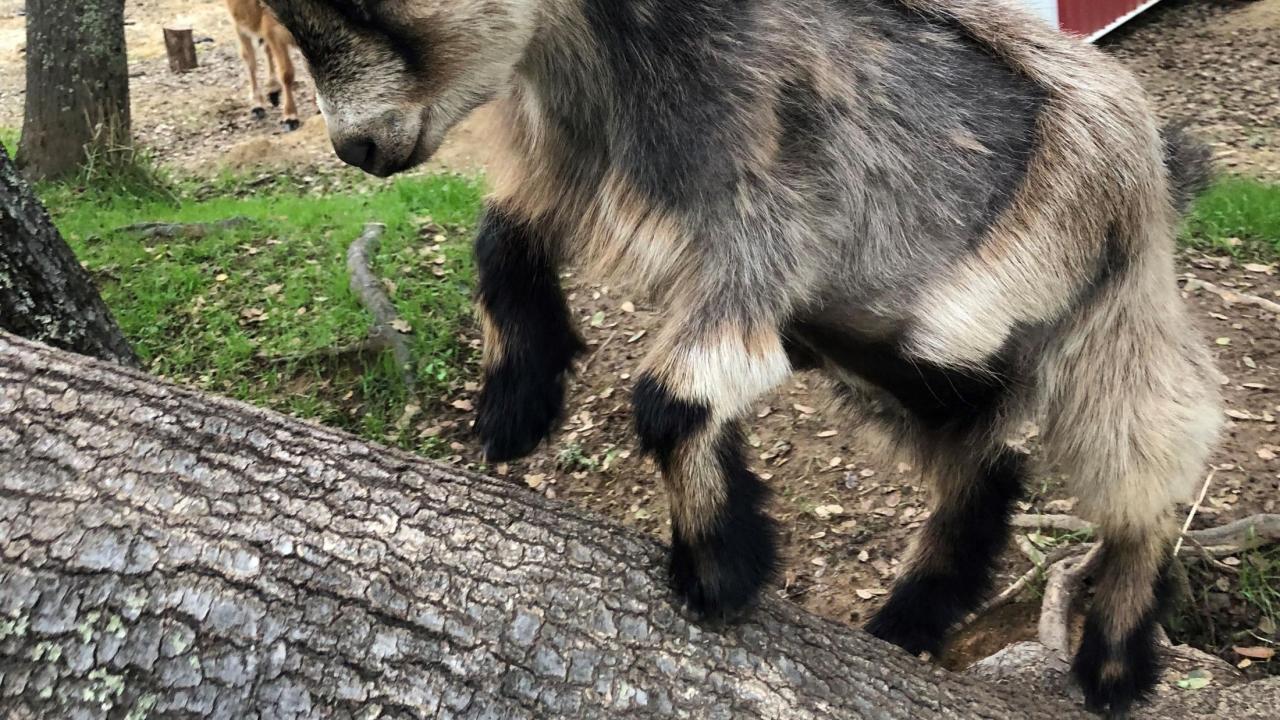
Goat Survives Dog Attack
Thor, a 7-month-old male pygmy goat, was brought to the UC Davis veterinary hospital after he and his pen mate were attacked by a dog. Unfortunately, his pen mate did not survive the attack. Before bringing Thor to the hospital, his owner immediately called their primary veterinarian, Dr. Mary Pride Clark, who cleaned and sutured Thor’s wounds and administered antibiotics and pain medication. After initial emergency care, Dr. Clark, a UC Davis School of Veterinary Medicine alumna, suggested that Thor be seen by the experts in the UC Davis Livestock Medicine & Surgery Service for further evaluation and ongoing pain management.
Once at the veterinary hospital, Thor was seen by residents Drs. Emily Schaefer and Tara Urbano, and by board-certified specialists in large animal internal medicine Drs. Sarah Depenbrock and Meera Heller. To gain the full extent of Thor’s injuries, they performed an abdominal ultrasound which revealed no evidence of severe internal organ damage, and x-rays of his most severely affected leg.
Thor was visibly painful in his left front limb; there was obvious bite damage, and Thor was unable to use the limb. Luckily, x-rays did not show any fractures, however there was a clear soft tissue defect over his triceps muscle confirming serious damage to muscles necessary to use the limb.
An intravenous catheter was placed to facilitate consistent administration of pain medications and antibiotics, as well as to maintain hydration. Thor was sedated and his wounds were again thoroughly cleaned and assessed for depth and extent of tissue damage. Drains were placed in the deep wounds to improve drainage and prevent growth of anaerobic bacteria (bacteria that grow in tissue not exposed to oxygen).
Thor’s most serious wounds included:
• A large puncture on his left ribcage behind his elbow. This wound communicated with a large pocket of gas overlying a left triceps muscle tear.
• A deep puncture on his buttocks, associated with a large skin tear.
• A deep puncture on his left neck.
The wounds were all flushed and cleaned twice daily during Thor’s 10-day hospitalization.
Thor was also given a tetanus vaccine booster to prevent developing tetanus from his deep puncture wounds, and a rabies vaccine as a precaution, although the dog was not a rabies suspect.
Due to the tear in his left triceps muscle, Thor had a difficult time locking his carpus (front knee) in extension, preventing him from standing on it. In order to help him extend his knee, a small splint was wrapped on the back of the leg, enabling him to move more normally. After a week in the splint, the triceps muscle was able to start scarring down, and Thor began bearing more weight on the limb. By the time of his discharge, his care team was pleased with the progress the limb made.
Thor returned home with follow-up care by Dr. Clark, and a final recheck appointment with the UC Davis team. Thor’s owners report he healed nicely with barely any noticeable lameness.
The unfortunate attack on Thor underscores the necessity to keep dogs properly contained and separate from goats or other small ruminants. Even otherwise well-behaved pet dogs can kill or seriously injure goats. While both animals can reach high levels of domestication, their interaction can quickly turn fatal. Some owners of small ruminants use specially-trained guard dogs to protect their sheep or goats; these dogs have been specifically raised to protect the herd or flock and may even kill an intruding dog – another reason to keep dogs away from small ruminants.
# # #
UC Davis Goat Day is January 20, 2018
